The Intel 6th Gen Skylake Review: Core i7-6700K and i5-6600K Tested
by Ian Cutress on August 5, 2015 8:00 AM ESTWhat You Can Buy: Windows Professional Performance
Agisoft Photoscan – 2D to 3D Image Manipulation: link
Agisoft Photoscan creates 3D models from 2D images, a process which is very computationally expensive. The algorithm is split into four distinct phases, and different phases of the model reconstruction require either fast memory, fast IPC, more cores, or even OpenCL compute devices to hand. Agisoft supplied us with a special version of the software to script the process, where we take 50 images of a stately home and convert it into a medium quality model. This benchmark typically takes around 15-20 minutes on a high end PC on the CPU alone, with GPUs reducing the time.
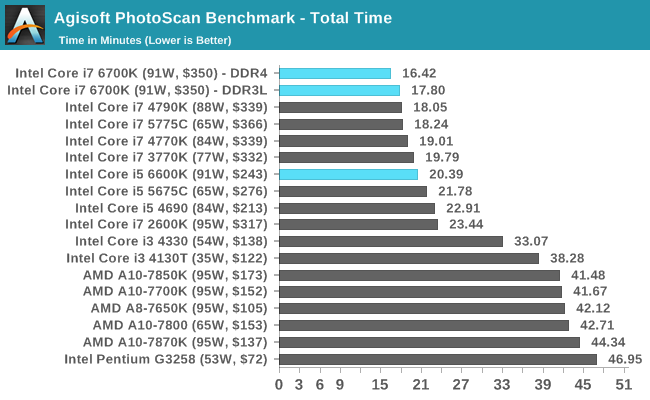
Cinebench R15
Cinebench is a benchmark based around Cinema 4D, and is fairly well known among enthusiasts for stressing the CPU for a provided workload. Results are given as a score, where higher is better.
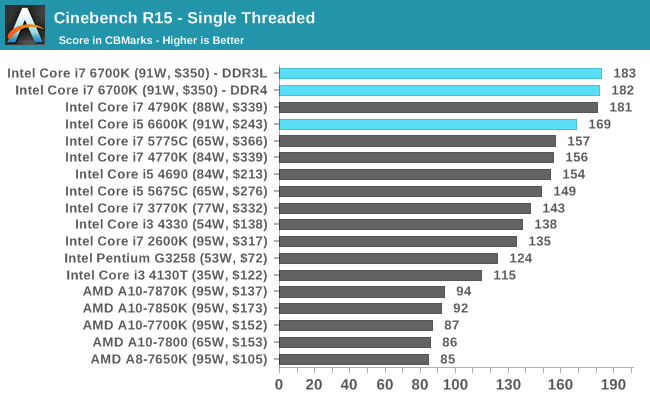
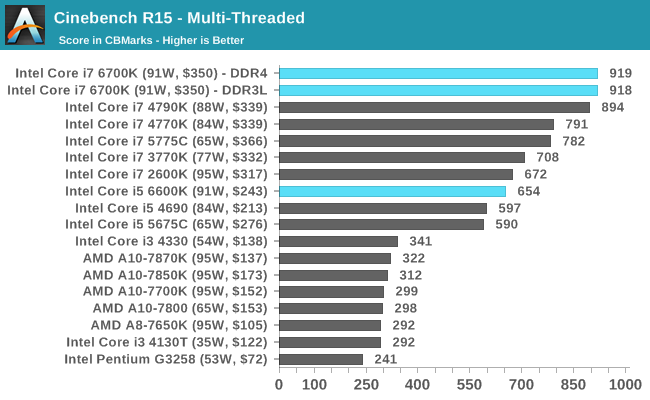
HandBrake v0.9.9: link
For HandBrake, we take two videos (a 2h20 640x266 DVD rip and a 10min double UHD 3840x4320 animation short) and convert them to x264 format in an MP4 container. Results are given in terms of the frames per second processed, and HandBrake uses as many threads as possible.
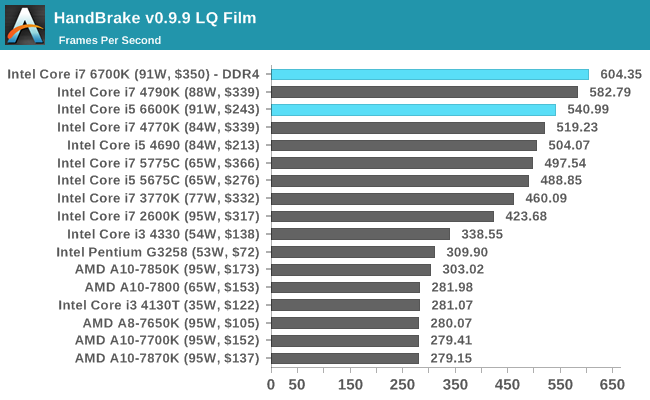
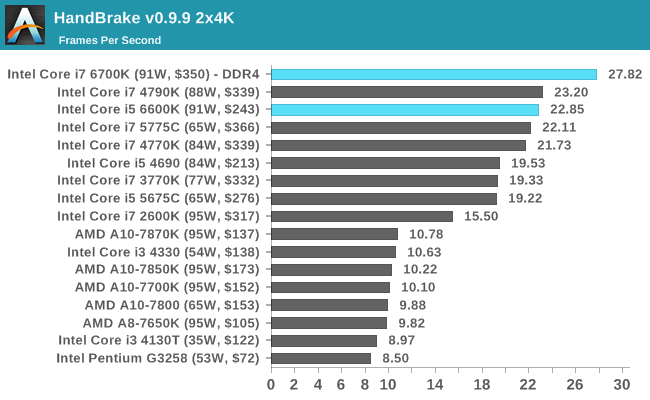
Hybrid x265
Hybrid is a new benchmark, where we take a 4K 1500 frame video and convert it into an x265 format without audio. Results are given in frames per second.
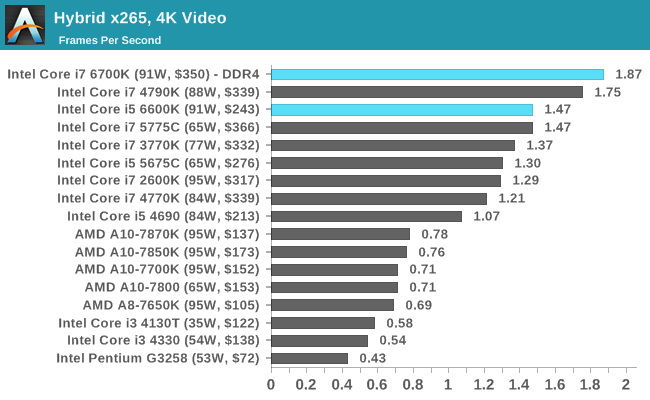










477 Comments
View All Comments
medi03 - Thursday, August 6, 2015 - link
Yeah. Blaming Intel that HP didn't want to use FASTER AMD CPUs FOR FREE, fearing Intel's illegal revenge is just nuts.AMD Athlon 64's beat Intel in all regards, they were faster, cheaper and less power hungry. Yet Intel was selling several times more Prescotts,
Not being able to profit even in a situation when you have superior product (despite much modest R&D budget), yeah, why blame intel.
MrBungle123 - Sunday, August 9, 2015 - link
In the Athlon 64 days, yes, AMD had a better product but the cold hard truth behind the curtain was that AMD didn't have the manufacturing capacity to supply everyone that Intel was feeding chips to.silverblue - Thursday, August 6, 2015 - link
A "tweaked 8-core Ph2"? Putting aside the fact that significant changes would've been required to the fetch and retire hardware (the integer units themselves were very capable but were underutilised), a better IMC and all the modern instruction sets that K10 didn't support, AMD had already developed its replacement. It probably would've buried them to have to shelve Bulldozer (twice, it turns out) and redevelop what was essentially a 12-year old micro-architecture.AMD were under pressure to deliver Bulldozer hence the cutting of corners and the decision to go with GF's poor 32nm process as they simply didn't have any alternative (plus I imagine they were promised far more than GF could deliver). Phenom II was not enough against Nehalem, let alone Sandy Bridge.
Blaming Intel doesn't help either as AMD couldn't exactly saturate the market with their products even when they were fabbing them themselves, however I think the huge drop in mainstream CPU prices when Core 2 was released along with the huge price paid for ATi did more damage than any bribing of retailers and systems manufacturers.
nikaldro - Wednesday, August 5, 2015 - link
40% over excavator, with 8 cores, good clockspeeds and good pricing doesn't sound that bad. I'll wait till Zen comes out, then decide.Spoelie - Thursday, August 6, 2015 - link
IPC difference between piledriver and skylake amounts to 80%... Lets hope excavator's IPC is better than anticipated and 40% is sandbagging it a bit.Given AMD's track record of overpromising and underdelivering, I'm afraid Zen will massively disappoint.
Asomething - Thursday, August 6, 2015 - link
Well it will only be behind by something like 15-25% if the difference between piledriver and skylake is 80% since piledriver to excavator is supposed to be a good 20% jump. If amd can manage to catchup in any meaningful way and make chips that can touch 5ghz then things might turn out ok.mapesdhs - Thursday, August 6, 2015 - link
Catchup will not be good enough. They need to be usefully competitive to pull people away from Intel into a platform switch, especially business, who have to think about this sort of thing for the long haul, and AMD's track record has been pretty woeful in this regard. I hope they can bring it to the table with Zen, but I'll believe it when I see it. Highly unlikely Intel isn't planning to either splat its prices or shove up performance, etc., if they need to when Zen comes out, especially for consumer CPUs. We know what's really possible based on how many cores, TDP, clock rates, etc. are used for the XEONs, but that potential just hasn't been put into a consumer chip yet.Remember, Intel could have released an 8-core for X79, but they didn't because there was no need; indeed the 3930K *is* an 8-core, just with 2 cores disabled (read the reviews). Ever since then, again and again, Intel has held back what it's perfectly capable of producing if it wanted to. The low clock of the 5960X is yet another example, it could easily be much higher.
MapRef41N93W - Friday, August 7, 2015 - link
You're assuming it's going to be a flat 40% over Excavator and not a best case scenario 40% (like every single AMD future performance projection always is...). It's more than likely a flat 20% IPC increase which puts it even behind Nehalem IPC wise.Top off the fact that it's AMD's first FinFET part (look at the penalty Intel paid in clockspeed with the transition to FinFET with IB/HW) and a transition to a new scalable uARCH (again look at the clockspeed hit Intel took when going from Netburst to scalable core arch, very similar to what AMD is doing now actually) and I can see Zen parts clocking horribly on top of that. Being on a Samsung node that is designed with low power in mind won't help their case either.
You may get an 8 core Zen part for $300-$400 but it probably won't clock worth a damn and end up at 3.5-4GHz on average. So it would be a much worse choice than a 5820k for most people.
mapesdhs - Wednesday, August 12, 2015 - link
Btw, I wasn't assuming anything about Zen, I really haven't a clue how it'll compare to Intel's offerings of the day. I hope it's good, but with all that's happened before, I hope for the best but expect the worst, though I'd like to be wrong.Azix - Friday, August 21, 2015 - link
You guys are being pretty negative on AMD. AMD tried to do an 8core chip on 32nm, maybe that was their mistake. The market wasn't even ready considering how long that way and where we are now. I do think intel got them pretty badly with their cheatingThe next processors are on a much better process. Based on the process alone we would expect a significant bit more performance than some seem willing to allow. Not to mention the original architecture was designed on a 32nm process. It's no surprise it would fall that far behind intel who is currently on 14nm. As time progresses though, those process jumps will take intel longer and longer. AMD will be much closer. Next year will be the first these two are on the same process (similar anyway). in a long while and it will last till at least 2017. AMD should be able to pick up some CPU sales next year and hopefully return to profitability. Intel also enjoys ddr4 support.
Stop pushing old 32nm architectures and crappy motherboards.